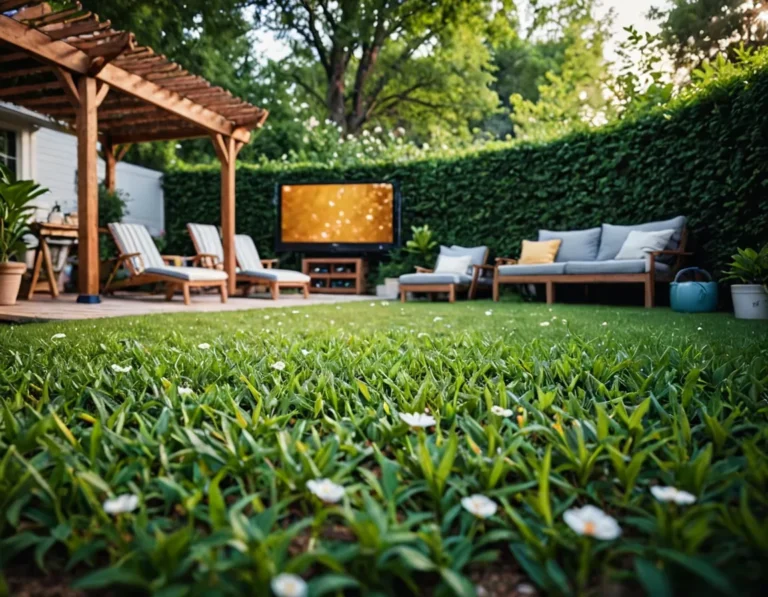Learn How to Create an Eco-Friendly Backyard with Sustainable Materials and Practices
Creating an eco-friendly backyard is a rewarding way to contribute to environmental conservation while enjoying a beautiful outdoor space. In this guide, we’ll walk you through various sustainable materials and practices to transform your backyard into an eco-friendly haven.
1. Choose Native Plants
Native plants are adapted to your local climate and soil, which means they require less water, fertilizers, and pesticides. Here’s why you should consider them:
| Benefits of Native Plants | Details |
|---|---|
| Low Maintenance | Requires less water and care |
| Supports Local Wildlife | Provides habitat and food for local species |
| Drought Resistant | Thrives in local climate conditions |
Examples of Native Plants:
- Eastern United States: Black-eyed Susan, Purple Coneflower
- Western United States: California Poppy, Douglas Iris
2. Use Recycled Materials
Incorporating recycled materials into your backyard design reduces waste and minimizes the environmental impact of your project.
| Recycled Material Ideas | How to Use Them |
|---|---|
| Recycled Wood | Decking, fencing, garden beds |
| Recycled Plastic | Outdoor furniture, planters |
| Reclaimed Bricks | Pathways, garden borders |
Tip: Check local salvage yards or online marketplaces for recycled materials.
3. Install a Rainwater Harvesting System
Rainwater harvesting is an excellent way to conserve water and reduce your water bill. It involves collecting and storing rainwater for garden irrigation and other uses.
| Rainwater Harvesting Benefits | Details |
|---|---|
| Water Conservation | Reduces dependence on municipal water |
| Cost Savings | Lowers water bills |
| Eco-Friendly | Decreases runoff and erosion |
How to Install:
- Choose a Collection System: Gutters, downspouts, and a storage tank or barrel.
- Set Up Filtration: Ensure the water is clean by using filters and screens.
- Distribute Water: Connect a hose or irrigation system to the storage tank.
4. Create a Composting Area
Composting turns kitchen scraps and yard waste into nutrient-rich soil, reducing the need for chemical fertilizers.
| Composting Benefits | Details |
|---|---|
| Reduces Waste | Decreases landfill use |
| Enhances Soil | Improves soil fertility and structure |
| Lowers Carbon Footprint | Decreases greenhouse gas emissions |
Composting Tips:
- Use a mix of green (nitrogen-rich) and brown (carbon-rich) materials.
- Turn the compost regularly to aerate.
- Keep the compost moist but not waterlogged.
5. Opt for Solar Lighting
Solar-powered lights are energy-efficient and easy to install, making them a great choice for eco-friendly outdoor lighting.
| Solar Lighting Benefits | Details |
|---|---|
| Energy Efficiency | Uses renewable solar energy |
| Cost Savings | Reduces electricity bills |
| Low Maintenance | Easy to install and requires minimal upkeep |
Types of Solar Lights:
- Pathway Lights: Ideal for walkways and garden paths.
- Spotlights: Highlight specific features or plants.
- String Lights: Create ambiance for outdoor gatherings.
6. Use Permeable Paving
Permeable paving materials allow water to pass through, reducing runoff and promoting groundwater recharge.
| Permeable Paving Benefits | Details |
|---|---|
| Reduces Runoff | Prevents water from pooling on the surface |
| Recharges Groundwater | Allows water to seep into the ground |
| Eco-Friendly | Minimizes environmental impact |
Popular Permeable Materials:
- Gravel
- Permeable concrete
- Paving stones with gaps
7. Install a Green Roof or Wall
Green roofs and walls provide insulation, reduce energy use, and create habitats for wildlife.
| Green Roof/Wall Benefits | Details |
|---|---|
| Insulation | Regulates building temperature |
| Energy Efficiency | Reduces heating and cooling costs |
| Wildlife Habitat | Supports biodiversity |
How to Install:
- Choose the Right Plants: Select hardy, low-maintenance species.
- Install Proper Drainage: Ensure water doesn’t pool.
- Use Lightweight Soil: Specialized soil mixes are available.
8. Build a Natural Habitat
Creating a natural habitat supports local wildlife and enhances biodiversity.
| Natural Habitat Features | Benefits |
|---|---|
| Birdhouses | Provides shelter for birds |
| Ponds | Supports aquatic life |
| Log Piles | Habitat for insects and small animals |
Tips for a Successful Habitat:
- Provide water sources like bird baths or small ponds.
- Plant a variety of flowering plants to attract pollinators.
- Avoid using pesticides and chemicals.
9. Grow Your Own Food
Starting a vegetable garden is a sustainable way to enjoy fresh, organic produce while reducing your carbon footprint.
| Homegrown Food Benefits | Details |
|---|---|
| Fresh Produce | Access to fresh, organic vegetables |
| Cost Savings | Reduces grocery bills |
| Sustainable Living | Decreases carbon footprint |
Beginner’s Vegetable Garden Plan:
- Easy-to-Grow Vegetables: Tomatoes, lettuce, beans
- Herbs: Basil, mint, rosemary
- Raised Beds: Use raised beds for better soil control
10. Practice Water-Wise Gardening
Water-wise gardening techniques help conserve water and ensure your plants thrive.
| Water-Wise Gardening Tips | Benefits |
|---|---|
| Mulching | Retains soil moisture and reduces evaporation |
| Drip Irrigation | Delivers water directly to plant roots |
| Drought-Tolerant Plants | Requires less water and maintenance |
Water-Wise Plant Examples:
- Succulents
- Lavender
- Yarrow
Conclusion
Transforming your backyard into an eco-friendly space is achievable with the right materials and practices. By choosing native plants, using recycled materials, and adopting water-wise techniques, you can create a sustainable and beautiful outdoor area. Start today and enjoy the benefits of an eco-friendly backyard!
